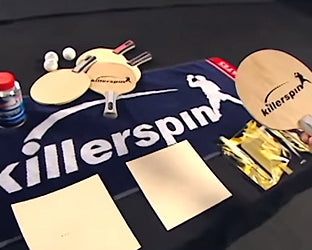
How to Assemble a Table Tennis Racket
Competition table tennis equipment is very different from recreational equipment. The style we'll teach you requires a high friction rubber. Its smooth, grippy surface can impart lots of spin. In one on one practice you should use 3-star balls exclusively because they bounce evenly and allow to keep a rally going. If you do multi-ball practice with someone feeding balls out of a bucket, cheaper practice balls will be fine. The better the table you play on, the fast your improvement, because of a more even bounce. Professional rackets and rubber are usually sold separately.
Here's how you assemble a racket. It is called inverted rubber because of the way the top sheet is attached to the sponge. It's designed to produce very strong spin. Make sure you touch the rubber surface as little as necessary. Rubber is available with different sponge thicknesses. The thicker, the faster, but the less control.
Most attack players use between 2.0mm and 2.2mm thickness. Table tennis glue is specially formulated to ensure a good bond, but still allow easy rubber removal. Rackets come in many different configurations: 5-ply and 7-ply blades are most common. Some have graphite or fiberglass layers. The quality of the blade is very important in the performance of the racket. Putting good rubber on cheap wood is as bad as having old rubber on a good blade - it just won't work. Get something good and maintain it so you know, whatever happens, it's not the equipment's fault.
Let the glue dry. You should always pay attention to the grippiness of the rubber, otherwise you might start adjusting your stroke to the declining condition of the rubber. Carefully line up the lower edge of the rubber with the handle. Lay the rubber down on the blade and gently roll it on to ensure even adhesion. You'll need a good pair of scissors so you can cut the rubber cleanly, following the edge of the blade. The racket can last years if you take good care of it. The life of the rubber depends on many factors, including how often you play, how hard you play, and how dusty your table tennis room is. It can be weeks or months.
When you're ready to replace the rubber, carefully peel the old sheet off the blade across the grain of the wood so you don't pull up any wood fibers. After playing, you should always clean the rubber with a table tennis rubber cleaner and store the racket in a racket case.
